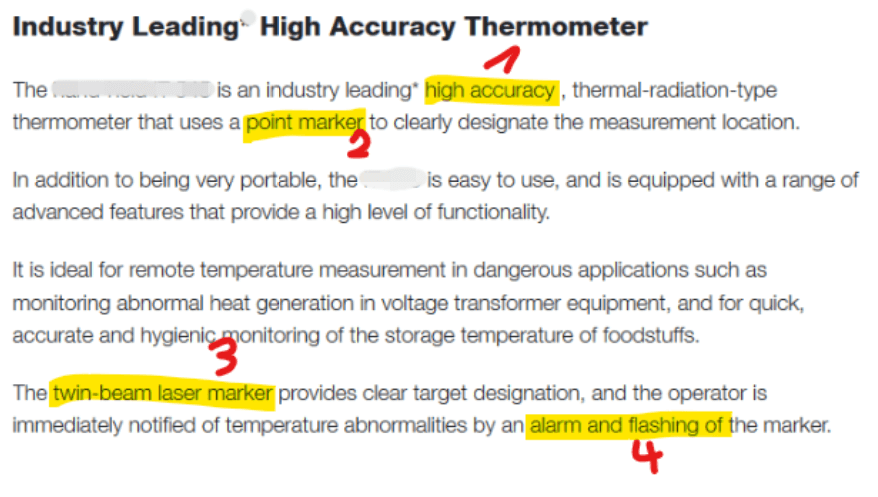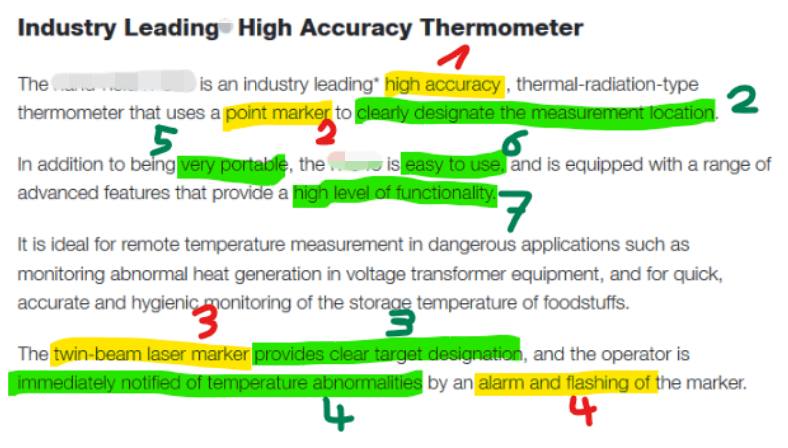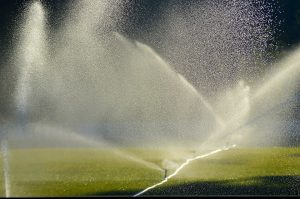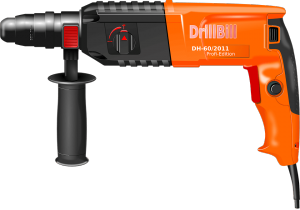
When businesses prepare purchasing decisions they rely more than ever on the internet as the prime source of information. This is where users search for solutions to their work challenges. What they look for is the right information for their current level in their customer journey.
In this blog post, I’ll show you how focusing your product description writing on benefits for the buyer can drive your sales leads. With the help of some easy to comprehend examples, I’ll introduce you to the FAB technique. You’ll learn how to progress a product feature (F) into its advantages (A), and from there to its benefits (B).

A product benefit is what answers the purchasers question “What is it that I gain form buying this product?” This is the core question you need to ask yourself. You need to highlight the product benefits in your product description writing for brochures, websites and online portals.
Customers don’t care what your product can do and how proud you are of this. They are only interested in what it can do for them.
The right place for product features is the datasheet. Advantages are important, but only product benefits can be experienced by the potential customer. Only when you’ve worked out what the benefits are can you write product descriptions that distinguish you from your competitors and enhance sales.
Not unusual: Product descriptions that mention no product benefit at all
In B2B businesses, product descriptions are written by either technology professionals (because they are well acquainted with the product features) or by marketing and product managers, based on a briefing by product developers. While many know a few advantages of the products, benefits to the buyer often remain in the dark. That, at least, is what the product descriptions I come across suggest.
New product descriptions for a launch
When a new product is launched into the market, creating a product brochure is often the first thing the marketing department does. Marketing typically receives its information input from product developers. This is usually a list of product features that developers typically take from the technical specifications.
In general, developers know little about the benefits of a product to the purchasers. And this is where the dilemma unfolds: marketing is under pressure to create a brochure by a certain deadline even though the product benefits haven’t been established. Brochures of this kind tend to escort their readers from one product feature to the next.
Because no one in the company gives the product benefits any attention, there is a deceptive sense of certainty, of the type “Our product has an autosampler with 96 positions, the competitor’s product only has 48. Ours is clearly better, that’s plain to see for every potential buyer”. But what is the benefit of 96 positions to the lab? Are 96 positions really relevant?
The initial brochure typically acts as a template. It is used as the basis for writing the product’s web page. So again, only product features are communicated. Potential buyers find nothing about the product benefits and what they really want to know remains unanswered:
- Can I solve my work task using this product?
- Can I use this product in my work environment?
- Is this product suitable for me?
To get sufficient sales leads, maintaining a web page on your website isn’t good enough. That’s why marketing managers also advertise on online portals for specific industries. However, the product descriptions they place on these are usually just transferred to these portals by copy and paste. Again, the product benefits don’t come across!
Poor product descriptions impair sales lead generation. They cost a company more through lost revenues than it costs to write benefit-focused product descriptions.
The solution: Win them over by getting the product benefits across
Relevant product benefits lend substance to your product descriptions. They persuade readers and help you to gain many more sales leads than before.
Most of the visitors that search engines like Google send to a product page on your website will be in phase 3 of the five-phase customer journey. They are looking for a solution to a previously identified problem. This early “flirtation” phase is not about technical details. The questions these visitors have call for answers:
- Can I solve my work task using this product?
- Can I use this product in my work environment?
- Is this product suitable for me?
The FAB technique to find out the product benefits
For ten years I have been using the FAB technique successfully to carve out product benefits. I approach the task systematically; initially I make a list with the fact-based product features. For each feature I note between one and three advantages.
In the next step, I put myself in the buyer’s place: which specific benefits does an advantage have for the purchaser? That’s the trickiest part of the whole thing. For this I have to be able to assess the buying situation from the other side.
Tip: Talk to your sales reps to find out the product benefits. They are in permanent contact with customers, so they ought to know best.
Example: A portable thermometer
Even for products that have already been introduced into the market, the benefit-focused approach is worthwhile because most product description writing is not done from the customer’s perspective. I’ll demonstrate this using a web page text for a portable thermometer.
First I highlighted in yellow the product features mentioned in the text and numbered them consecutively.

Then I searched the text for advantages and highlighted those in green. Where possible, I assigned the advantages to the four previously identified product features.

Result: The product description on the web page yields 4 product features and 7 advantages. What it doesn’t do is explain features such as “easy to use”. It is left to the imagination of the reader what it means. Product benefits are not mentioned at all. A potential buyer has to think long and hard about why to purchase this product and not the competitor’s.
What this example illustrates is that product description writing tends to be performed from an internal corporate perspective. The prospective buyer’s question “What do I gain from buying this product?” isn’t answered.
Tip: Take three highlighters to mark the features, advantages and benefits of one of your product descriptions in different colours. I suspect the result will look similar to the text in our example: many features, few advantages, no benefits.
Applying the FAB technique systematically
In our “portable thermometer” example the vendor’s text doesn’t mention any product benefits. Using three other examples I’ll show you how the FAB technique gets you from product feature to advantage to benefit systematically.
Example 1: Irrigation pump

Product | Product feature | Product advantage | Product benefit |
| Irrigation pump | Flow rate of 10 m³/h | Allows you to use several lawn sprinklers simultaneously | Saves you the tedious effort of moving the lawn sprinkler around to irrigate a wide area |
For the product feature “flow rate” my benefit statement is: “Saves you the tedious effort of moving the lawn sprinkler around because you can use several lawn sprinklers simultaneously, as the irrigation pump can deliver 10 m³/h.
Example 2: Alfa Romeo

Product | Product feature | Product advantage | Product benefit |
| Alfa Romeo car | Adaptive Frontlights System (AFS) | Obstacles such as pedestrians or game detected earlier | Increased safety because you can react faster |
For the product feature “Adaptive Frontlights System (AFS)” my benefit statement is: “You are safer on the road when it’s dark because AFS lets you see obstacles, such as pedestrians or game, earlier due to the better illumination of the road.”
Example 3: Power drill

Product | Product feature | Product advantage | Product benefit |
| Power drill | Pneumatic percussion | Drills effortlessly through concrete | Saves 80% of the time conventional power drills need to drill holes into concrete |
For the product feature “pneumatic percussion” my benefit statement is: “Saves 80% of the time that conventional power drills need to drill holes into concrete because the pneumatic percussion feature lets you drill through concrete easier.”
Conclusions
Product descriptions in brochures, on web pages and in the product presentations of online portals contain too little about product benefits and too much about product features. This makes it more difficult for potential buyers to come to the buying decision, so they move on to the next supplier.
The FAB technique is a systematic line-of-argument approach to get from product features to advantages, and from there to product benefits. This lays the groundwork for product descriptions that sell better.
Do you find the presented FAB technique to be interesting? How do you go about in product description writing? I look forward to your comments and suggestions.


I like your acronym FAB- very smart. Great points about product decription. This is something that not many businesses put enough effort in.
Post Comment